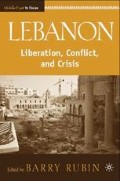Abstract
Lebanon’s civil war has been one of the most complex, multifaceted wars of modern times due to its hybrid nature, multiple participants (both state and non-state actors), and its impact on regional, and even global balances of power.
Access this chapter
Tax calculation will be finalised at checkout
Purchases are for personal use only
Preview
Unable to display preview. Download preview PDF.
Notes
For more detailed studies on the Palestinians, see, e.g., Yezid Sayigh, “Palestinian Military Performance in the 1982 War,” Journal of Palestine Studies, Vol. 12, No. 4 (Summer 1983), pp. 3–24.
Ghassan Tueni, Une Guerre pour les Autres (Paris: Editions Lattès, 1985).
For a good study from this vantage point, see Farid El-Khazen, The Breakdown of the State in Lebanon 1967–1976 (London: I. B. Tauris, 2000).
See the various anecdotes in Yussef Bazzi’s Yasser Arafat Looked at Me and Smiled (Diary of a Fighter) (Beirut: Dar el-Kotob, 2005).
Lawrence L. Whetten, “The Military Dimension,” in P. Edward Haley and Lewis W. Snider (eds.), Lebanon in Crisis: Participants and Issues (Syracuse: Syracuse University Press, 1979), p. 88.
Samir Kassir, La guerre du Liban: De la dissension nationale au conflit régional, 1975–1982 (Paris: Karthala/Cermoc, 1994), p. 150.
Lewis W. Snider, “The Lebanese Forces: Their Origins and Role in Lebanon’s Politics,” Middle East Journal, Vol. 38, No. 1 (Winter 1984), pp. 1–33.
The definitive study on the Phalanges’ organizational structure in the years before the 1975 war remains John P. Entelis, Pluralism and Party Transformation in Lebanon: Al-Kata’ib, 1936–1970 (Leiden: E. J. Brill, 1974).
See Itamar Rabinovich, The War for Lebanon, 1970–1985, revised edition (Ithaca and London: Cornell University Press, 1989), p. 65.
Marius Deeb, The Lebanese Civil War (New York: Praeger, 1980), pp. 25–28.
Dan Bavly and Eliahu Salpeter, Fire in Beirut: Israel’s War in Lebanon with the PLO (New York: Stein & Day, 1984), p. 52.
See Mordechai Nisan, The Conscience of Lebanon: A Political Biography of Etienne Sakr (Abu-Arz) (London: Frank Cass/Taylor & Francis, 2003).
Walid Khalidi, Conflict and Violence in Lebanon: Confrontation in the Middle East, fourth printing (Cambridge, MA: Harvard Studies in International Affairs, 1984), p. 77.
See Fouad Ajami, The Vanished Imam: Musa al Sadr and the Shia of Lebanon (London: I. B. Tauris, 1986), pp. 168–175.
For more on these aspects and their role in the organizational structure of Hizballah, see Magnus Ranstorp, Hizb’allah in Lebanon: The Politics of the Western Hostage Crisis (New York and London: Palgrave Macmillan, 1997).
Martin Kramer, “Hizbullah: The Calculus of Jihad,” in M. Marty and R. S. Appleby (eds.), Fundamentalisms and the State: Remaking Polities, Economies, and Militance (The Fundamentalism Project, Vol. 3) (Chicago: University of Chicago Press, 1993), pp. 539–556
Ibid., p. 40. “The zoom lens allowed Christian gunners to focus in on buildings and windows of buildings where the enemy was located. At distances from four to eight kilometers the ZU-57 proved very effective.” For a picture of the monitor-equipped ZU in action in a rural setting in Mount Lebanon, see Joseph G. Chami, Lebanon, Days of Tragedy 75–76 (Transaction Books: London and New Brunswick, 1984), p. 190.
Editor information
Editors and Affiliations
Copyright information
© 2009 Barry Rubin
About this chapter
Cite this chapter
Badran, T. (2009). Lebanon’s Militia Wars. In: Rubin, B. (eds) Lebanon. The Middle East in Focus. Palgrave Macmillan, New York. https://doi.org/10.1057/9780230622432_4
Download citation
DOI: https://doi.org/10.1057/9780230622432_4
Publisher Name: Palgrave Macmillan, New York
Print ISBN: 978-1-349-37326-0
Online ISBN: 978-0-230-62243-2
eBook Packages: Palgrave Political & Intern. Studies CollectionPolitical Science and International Studies (R0)

